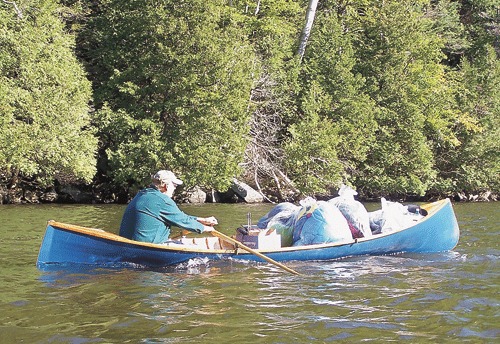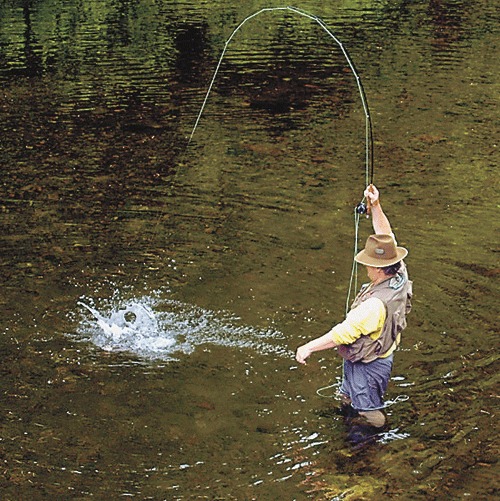Adirondack guides adjust, thrive in modern times

Photo by Joe Hackett A guide pulls hard on the oars, while hauling a full load of supplies into camp for the weekend. The requirements of a strong back and a solid constitution are as evident in today’s guides as they were during the “Heydays of the Adirondacks.”
The stereotypical image of an Adirondack guide is that of a grizzled old woodsman dressed in woolies that are hitched up by a set of red suspenders and cuffed to permit a fair view of a pair of rubber-bottomed boots.
His legs are bowed and shoulders stooped from carrying heavy loads. With a chaw of tobacco set squarely in his jaw, he can curse a blue streak or lay on a Sunday sermon with equal fervor, and then get on with his day.
This image was first fostered by writers who discovered guides working the woods and waters of the Adirondacks in the mid-1800s. Transporting their “sports” in an Adirondack guideboat, the waterborne pickup truck of the day, guides soon became the colloquial “ambassadors to the wilderness.”
The occupation has changed considerably over the past century. Today’s guides are a much more diverse group and, although many still carry on the outdoor sporting traditions of hunting and fishing, the occupation has diversified. No longer do guides serve a strictly bait and bullet crowd that is intent on harvesting a big brook trout or a bagging a trophy buck.
Modern “sports” are more intent on learning the habits of such prey and the intricacies of their habitat or the threats to their environment. Guides for “birders” no longer carry shotguns, but rather binoculars, a bird book and even a spotting scope that permits the sport to capture a digital image of their prey as proof for their life list of birds.

Photo provided A guide’s office ranges from the streamside to a mountaintop, and all points between.
In 2003, the New York State Outdoor Guides Association (NYSOGA) provided another indication of just much times have changed when the membership elected Sheila Young of Saranac Lake as president of the organization.
For the first time in the history of the organization, which has roots reaching back over 120 years to the original Adirondack Guides Association, the association chose a woman as its leader.
Young isn’t alone in the woods. Women currently comprise about 20 percent of the state’s licensed guides. As clients’ preferences change and the interest in women-only trips continues to grow, the demand for female guides will surely expand.
Guiding is considered one of the few indigenous Adirondack occupations that continues to thrive in modern times.
Originally, its history can be traced back to 1826 when David Henderson hired an Indian, Elijah Lewis Benedict, to lead him and his party from North Elba through Indian Pass to the site of iron deposits on the Upper Hudson River. His pay for leading Henderson to the location where the “rivers ran red like blood” was listed as $1.50 and a pipe of tobacco.
Henderson understood the reason the river ran red like blood was due to the rust from iron ore, and he eventually established a profitable iron-mining operation and the village of Adirondac.
Fortunately, a guide’s rates have increased and so too have the demands. Today, the occupation includes whitewater rafting guides, ski instructors, fly fishing guides, outdoor skills instructors, wilderness-based therapy counselors and nature interpreters, in addition to the traditional hunting and fishing guides.
A few large private clubs still carry on the tradition and employ a number of guides, most notably the AuSable Club in Keene Valley and the Adirondack League Club near Old Forge. In some instances, the club guides are members of the fourth or fifth generation of the same families that have been working on these properties since the 1890s.
Currently, there is a career path available for those seeking to attain the outdoor skills necessary to pursue the occupation. At the same time, there is a burgeoning demand for such skilled workers. This process offers promise for the future.
According to U.S. Department of Labor statistics, overall employment of recreation and fitness workers – of which recreation accounts for 62 percent – is expected to grow faster than average for all occupations through the next decade. The public is always going to need recreation and as society increasingly becomes dependent on technology, it is expected there will be a greater need for a return to nature.
Wilderness education programs provide the specialized preparation that individuals require to become leaders and educators in wild settings. Since the 1960s when wilderness areas were first designated on public lands in the United States, there has been a steady increase in wilderness use by the general public and organized groups.
The field of wilderness education has grown and matured in response to the burgeoning industry. Today there are more than 1,000 wilderness experience programs across the United States with a growth rate of about 15 percent per year. Across the Park, colleges are now offering academic programs to meet this expected demand.
Paul Smith’s College, which is an affiliate of the Wilderness Education Association, offers two- and four-year degree programs in forest recreation, outdoor education and recreation, adventure travel and ecotourism management.
North Country Community College in Saranac Lake also has a Wilderness Education Association-affiliated program and an associate’s degree program in wilderness recreation leadership.
Both St. Lawrence University and SUNY Potsdam offer minors in the field. St. Lawrence also has a program that includes an extended wilderness experience program based at a yurt village in a remote location in the Adirondacks, where the students have no cars, television, phones or internet.
SUNY Plattsburgh has a two- and four-year program in expeditionary studies, which is affiliated with the National Outdoor Leadership School (NOLS). SUNY Adirondack in Glens Falls has instituted an associate’s degree program in adventure sports leadership and management at its Adventure Sports Center.
The program hopes to educate and credential highly skilled and competent adventure professionals prepared to occupy positions of responsibility in order to enhance the quality and quantity of adventure professionals in the Adirondack region.
“Where are the jobs?” many will ask. Answer: in nature centers and campgrounds, visitor centers and museums, public and private camps, private recreation businesses, outfitters, guide services, ski areas and leadership positions with outdoor equipment manufacturers and retail sales companies.
“What will we do?” is another good question. You’ll be a wilderness therapy counselor, field instructor, equestrian trail guide, kayak guide, waterfront director, lifeguard, mountain guide, climbing instructor, kayak guide, sailing instructor, horseback riding instructor, naturalist, conservation crew leaders, captain of the whale watching boat, leave no trace master educator, fly fishing guide, birding interpreter or ski patroller.
“How do I get started?” For those interested in pursuing the guide occupation, a good place to start is with the New York State Outdoor Guides Association. NYSOGA is the guide’s trade group, and it provides both the training and a host of other necessary elements for guides to promote and protect their occupation.
This year, the annual Guides Rendezvous will be hosted at the White Eagle Conference Center in Hamilton from Thursday, March 22 to Sunday, March 25.
The conference’s theme is “Re-Kindling Our Campfire.” The gathering will feature state Department of Environmental Conservation guide exams, training and seminars. For further information, visit www.nysoga.org or call 1-866-469-7642.
- Photo provided A guide’s office ranges from the streamside to a mountaintop, and all points between.





